
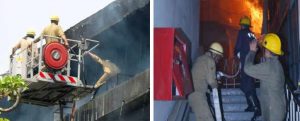 What is Risk (severity Probability)
What is Risk (severity Probability)
“A situation involving exposure to danger”
Synonyms: possibility, chance, probability, likelihood, danger, peril, threat, menace, fear, prospect
“Do not use the stove inside a tent because of the risk of fire”
“Expose (someone or something valued) to danger, harm, or loss”
“A father risked his life to save his twin babies from a fire”
Business risk : A probability or threat of damage, injury, liability, loss, or any other negative occurrence that is caused by external or internal vulnerabilities, and that may be avoided through pre-emptive action.
What is Occupation Hazards
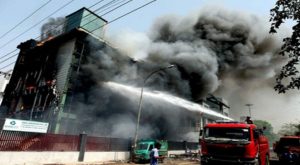 “ An occupational hazard is a hazard experienced in the workplace. … Occupational hazard as a term signifies both long-term and short-term risks associated with the workplace environment and is a field of study within occupational safety and health and public health ”
“ An occupational hazard is a hazard experienced in the workplace. … Occupational hazard as a term signifies both long-term and short-term risks associated with the workplace environment and is a field of study within occupational safety and health and public health ”
Occupational Hazards to fireman:
“Firefighters are exposed to serious chemical and physical hazards, to a degree that is unusual in the modem work force. The acute hazards of firefighting, primarily trauma, thermal injury, and smoke inhalation, are obvious”
“There are many situations where physical demands involve very strenuous work, force, repetition, awkward postures and prolonged activities, often under extreme conditions lead to long term Ergonomics injuries”
“Risk and Occupational Hazards of Firemen”
Firefighting is a highly unusual occupation and dangerous but is indispensable and even prestigious. The emergency response services sometimes enjoy public admiration for the act of bravery and public criticism also due to delayed response (traffic jammed and geographical location of fire stations) injury and death in line of duty. The fire-fighters are used to exposed to risks and occupational hazards.
- Due to an internment periods of exposure to extreme physical, psychological and mental stress on the job. The Behavioural disorder due to working of prolong duty hours, leave issue not spending quality time with family, which leads mental stress to them & family also.
- The risk and occupational Hazards to firemen is always a gray area for any emergency response services, government, private and research agencies.
- There might be numbers of excuses, constraints, priorities, lack of awareness, non-availability of funds and hurdles for implementation.
- First we need to create awareness among to fire fertility on clear understanding about what is risk and occupational hazards to fireman eitherthese are acceptableor not andacceptable with definedcontrol measures in place.
- An occupational hazards can be encompass as physical hazards (fall from height, trip, cut injury, expiation, road accidents, heat stroke, burn injury and handling of high pressurized firefighting equipment, exposure to high noise level and vibrations) diesel fumes, cancer, Cardiovascular disease, Neurological & sensory, exposure to various toxic and carcinogen chemical, toxic gases, fumes,dusts, radiological hazards, biological, psychosocial, ergonomics, Musculoskeletal (Low back pain, Osteoarthritis).
- The occupational hazards due to directly exposing to hazards due to non-availability of personnel protection equipment, improper use of PPE’s, unsuitable PPE’s, Nodecontamination process to washout of hazardous chemicals after every rescue and fire call, study for firemen health and complete medical and stress check-up for early detection of diseases and mental disorder.
- The above risks to fireman can be control by –Hierarchy of control are: Elimination (Physically removes the hazard), substitution (Replace the hazard), Engineering controls (Change the way people work), Personnel Protective equipment (Protect the fireman with best PPE’s).
- The above risk and occupational Hazards to fireman can be minimized or eliminated by mapping of each and every activity, encounter during rescue and firefighting operation based on visionary leadership, recent and past incident investigation recommendations in tabulated format with preventive action plan and online tracking mechanism, accessible to public domain for feedback for continual improvement.
- We need to create awareness on risk and occupational Hazards of fireman, various studies on occupation hazards, ergonomics, stress management, behaviour disorder, chronic disease, cancer detection in early stages to prevention programme and leveraging latest technologies.
HIRAC (Hazards Identification and risk control)
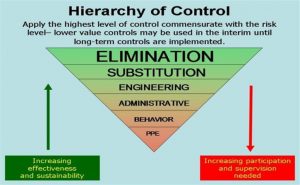 NFPA reports on Fire fighter death :
NFPA reports on Fire fighter death :
 Cardiac Issues Remain Leading Cause of On-duty FF Deaths
Cardiac Issues Remain Leading Cause of On-duty FF Deaths
Compressive model of Cardiovascular and chemical exposure risk in modern firefighting goals and objectives.
Potential reasons for on-duty cardiac disease related deaths
- Pulse rate goes up with alarms and sirens
- Physical burden of wearing 50+ pounds of protective equipment while working near maximal heart rates
- Heat stress and fluid loss can cause decreased cardiac output even with increased pulse
- Personal protection devises reduce environmental toxic exposure, but does not eliminate all toxins.
Cardiovascular Disease Death Risk Factors
Individual predictors
- > 45 years old
- Hypertension
- Smoking
- Previous diagnosis of CHD
Other risk factors
- Diabetes
- Hyper cholesterol (cholesterol > 200)
Cancer Risk
- Firefighters are twice, sometimes three times as likely, to develop testicular or skin cancer and leukemia.
- Brain cancer in firefighters with 20 years of experience is so common in Ontario, Canada that it is recognized as a workplace injury and victims are automatically compensated.
- At least 15 studies show a statistical link between brain cancer and firefighting
- Elevated mortality risks for brain tumor, cancers of lymphopoietic, bladder and kidney, and soft tissue sarcoma have been observed
- The overall risk of cancer among firefighters was significantly higher when compared to the general Florida population. Significant excess mortality observed for respiratory cancer and skin cancer.
- Cancers may not appear until later in life
Deadly Carbon monoxide gas, toxic chemical and other unburnt particle's hazards mitigation by ventilation & smoke management
Natural
- Mechanical
- HVAC
- Smoke fans.
- Positive pressure.
- Negative Pressure Ventilation
- Hydraulic
Decontamination of PPE’s after every emergency call
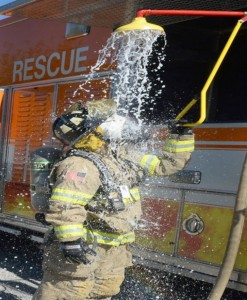 Immediate Actions You Can Takes To Reduce Your Cancer Risks
Immediate Actions You Can Takes To Reduce Your Cancer Risks
- Use SCBA set from initial attack to finished of overhaul.
- Do gross field decon of PPE to remove as much as sootand particulates as possible
- Use Wet –Nap or baby wipes to remove as much as soot from head, neck, jaw, throat and under arms and hands immediately and while still on scene
- Change your clothes and wash them immediately after fire.
- Shower thoroughly after a fire
- Clean your PPE, gloves, hood, helmet immediately after fire
- Do not take contaminated clothes or PPE home or store in vehicle.
- Decontamination offire apparatus interior after fire
- Keep bunker gears out of living and sleeping quarters.
- Stop using Tobacco products.
- Use sunscreen or sun block
- The importance of annual medical examination can not be overstated early detection and treatment are essential to increasing survival.
Heat stress ( Simulators based live firefighting training, firefighting operation & PPE’s)
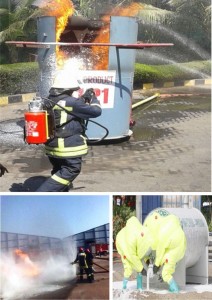 Symptoms of Heat Exhaustion
Symptoms of Heat Exhaustion
- Fainting
- Profuse sweating
- Headache
- Tingling sensations in the extremities
- Pallor (ashen color of the face)
- Dyspnea (shortness of breath)
- Nausea
- Vomiting
Heat Stress Management
- Most important factor to minimized heat/ radiation /chemical exposure level by rotational strategy of firefighter crew engaged in emergency with backup team.
- Identify basic heat stress terms and concepts.
- Sources of heat exposure that affect firefighters.
- Understand the added impact of personal protective equipment on heat stress.
- Understand the effects of heat stress on the human body.
- Understand the role of adaptation and acclimatization to environmental conditions and how they may benefit firefighters.
- Identify and treat the symptoms of minor heat injuries and illnesses.
- Identify and treat the symptoms of heat exhaustion.
- Identify and treat the symptoms heat stroke.
- Various methods for avoiding heat-related injuries.
Treatment for Heat Exhaustion
- Elevate the patient's legs and remove from the heat to a cool place.
- Water and/or salt replacement should be undertaken.
- Replacement of fluid using intravenous methods should be used.
- Mandatory continuous monitoring of the patient's condition in the field and evaluation of the patient's electrolyte status at a hospital.
- Recovery from heat exhaustion is usually rapid, but immediate return to duty is not advisable.
Proper Hydration
- The most critical factor in prevention of heat injury.
- Water must be replaced, both during exercise periods and at emergency scenes.
- Thirst should not be relied upon to stimulate drinking.
- Cool water and cups must be readily available at both exercise areas and emergency scenes and drinking encouraged.
Psychological Effects of Heat Stress
- Heat-acclimated firefighters will not be affected as quickly as those who are not acclimated.
- Heat stress reduces mental performance.
- Heat stress slows reaction time and decision time.
- Tasks that require attention to detail, concentration, and short-term memory and are not self-paced may degrade.
- Routine tasks are done more slowly and errors of omission are more common.
- Dehydration greater than 2% of body weight will adversely affect mental function of simple tasks.
The Impact of Physical Condition
- The risk of heat injury is much higher in overweight, unfit firefighters than in fit ones.
- Physical fitness programs designed to develop both cardiovascular and muscular fitness can be of great benefit in reducing heat casualties, although fit firefighters will have their limits as well
Heat Stress Management
Physical Fitness
- Strenuous training drills were a source of CHD deaths for firefighters lacking physical fitness
- Most fire departments have system of regular exercise.
- In one study 33% of fire fighters were measured as obese with this figure increasing to 40% four years later
Physical Exercise
- Daily is good idea
- At least 3-4 times a week of combined cardio fitness and weight training.
- Speak to medical professional before starting program if not already exercising.
Meditation (Critical Caves Rescue operation)
Thailand cave rescue: Meditation led by coach helped boys survive terrifying ordeal, family say : The team were then left trapped in the cave for more than two weeks before they were led to safety by rescue divers
Completed Physical Ability Test (CPAT)
In-house design and developed Completed Physical Ability Test (CPAT)
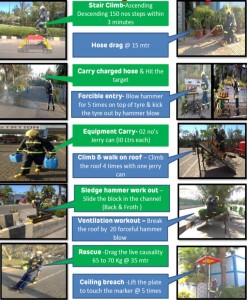 There are no standards and guidelines are available in India for physical and professional fitness assessment, endurance test, to ensured continual professional fitness. Which is required to performed rescue and firefighting operation for major emergency. In our country fire fighters are usually selected on their physical stats like and there athletic performance but the functional tasks test are not conducted which is necessary to perform during actual emergency. We too at APSEZ were recruiting fire fighters on their academic qualification, physical stats and athletic performance. We were having challenges regarding the quantification of physical ability of our fire fighters whether newly joined or existing. Although we were training our fire fighters to enhance their physical capability but we were not certain whether our fire fighters were ample strong physically to carry out the strenuous activity which has to be preform during emergencies for extended hours.
There are no standards and guidelines are available in India for physical and professional fitness assessment, endurance test, to ensured continual professional fitness. Which is required to performed rescue and firefighting operation for major emergency. In our country fire fighters are usually selected on their physical stats like and there athletic performance but the functional tasks test are not conducted which is necessary to perform during actual emergency. We too at APSEZ were recruiting fire fighters on their academic qualification, physical stats and athletic performance. We were having challenges regarding the quantification of physical ability of our fire fighters whether newly joined or existing. Although we were training our fire fighters to enhance their physical capability but we were not certain whether our fire fighters were ample strong physically to carry out the strenuous activity which has to be preform during emergencies for extended hours.
After successful completion of professional Fire Fighters PAT we took one step forward and organized competition of non professional firefighter (Operation, maintenance, procurement, services department employees and associates). To strengthened our Auxiliary Fire squad. APSEZ Fire services conducted first of its Kind Competition for Non Professional Fire Fighters christened as Ultimate Fire Fighter Challenge which comprises of Physical Ability Test of Non Professional Fire Fighters.
An Overview of How Emotional Intelligence Can Reduce Death and Injury for Firefighters
What is emotional intelligence?
Emotional intelligence (EI) refers to the ability to perceive, control and evaluate emotions
Why fire officers need emotional intelligence ?
- Beyond being technically skilled and competent, the best fire officers also possess what is known as emotional intelligence. Understanding the role of this competency is critical for all leaders to achieve their full potential
- In the workplace emotions are a defining factor of how we act and perform at work.
-
Emotions influence our thoughts and the decisions we make…
- deciding not to hire someone because “something just didn’t feel right”
- Who’s going to ask the boss for more resources or a pay rise when the boss is having “a bad day”
- Emotions also play a large role in our outward displays and behaviours, they help define…
– Our tone of voice
– Our body language
– Our facial expressions
1. Recognizing and Expressing Emotions (Self)
The skill of perceiving and understanding one’s own emotions
– The skill of expressing one’s own emotions effectively
2. Understanding Emotions (Others)
The skill of perceiving and understanding other’s emotions
3. Decision Making
The skill of using emotional information (self & others) in decision making
4. Managing Emotions
The skill of effectively managing one’s own emotions. The skill of influencing the moods & emotions of others
5. Controlling Emotions
The skill of effectively controlling strong emotional experiences and associated behaviours
What is Ergonomics?
Ergonomics hazards to firefighter
We will:
- Review the definition of ergonomics
- Review musculoskeletal risk factors
- Step through the process of conducting a hazard analysis
Common Activities Involving Ergonomic Hazards: Fire Fighting
- High rise fires
- Ventilation and overhaul procedures
- Hose laying operations
- Ladder work
- Forcible entry
- Extrications
- Extended procedures
- Hose rolling
- Carrying heavy equipment
- Physical exertion
Firefighter Life Safety Initiatives
- “Cultural change leadership, management, supervision, accountability personal responsibility”
- Enhance the personal and organizational accountability for health and safety throughout the fire service
- “Focus greater attention on the integration of risk management with incident management at all levels, including strategic, tactical, and planning responsibilities.
- All firefighters must be empowered to stop unsafe practices
- Develop and implement national standards for training, medical and physical fitness standards that are equally applicable to all firefighters, based on the duties they are expected to perform.
- Create a national research agenda and data collection system that relates to the initiatives.
- Utilize available technology wherever it can help produce higher levels of health and safety.
- Thoroughly investigate all firefighter fatalities, injuries, and near misses
- Firefighters and their families must have access to counseling and psychological support
- Public education must receive more resources and be championed as a critical fire and life safety program
- Safety must be a primary consideration in the design of apparatus and equipment.
About Author :- Mr. Rakesh Chaturvedi
 He is a science Graduate, Charter Engineer from Association of Building Engineers (UK), MI FIRE E (India & UK), Advance Diploma in Industrial Safety (MSBTE), Grade-I (IFE,indai) Diploma in Industrial Safety, Station Fire officer Course, Gold Medalist in Chemical Disaster Management course (National Civil Defence College , Nagpur, Maharashtra), his more than 40 number of technical paper published in National and International journals. He is working as Deputy General Manager Fire Services at Adaniport & Special economic Zone , Mundra, Kutch, Gujarat . He is having 22 years of working experience (Essar Steel India Ltd, Reliance refinery division, Jamnagar, Oil and Natural Gas Corporation limited, Surat, Bharat Heavy Electrical Limited, Bhopal ( MP) and Hindustan Zinc limited, Udaipur.
He is a science Graduate, Charter Engineer from Association of Building Engineers (UK), MI FIRE E (India & UK), Advance Diploma in Industrial Safety (MSBTE), Grade-I (IFE,indai) Diploma in Industrial Safety, Station Fire officer Course, Gold Medalist in Chemical Disaster Management course (National Civil Defence College , Nagpur, Maharashtra), his more than 40 number of technical paper published in National and International journals. He is working as Deputy General Manager Fire Services at Adaniport & Special economic Zone , Mundra, Kutch, Gujarat . He is having 22 years of working experience (Essar Steel India Ltd, Reliance refinery division, Jamnagar, Oil and Natural Gas Corporation limited, Surat, Bharat Heavy Electrical Limited, Bhopal ( MP) and Hindustan Zinc limited, Udaipur.















































